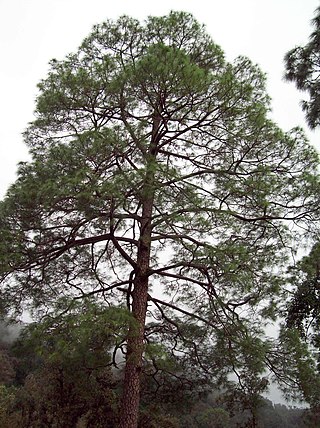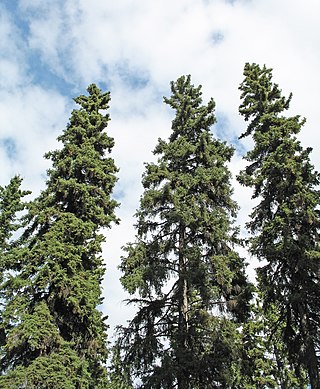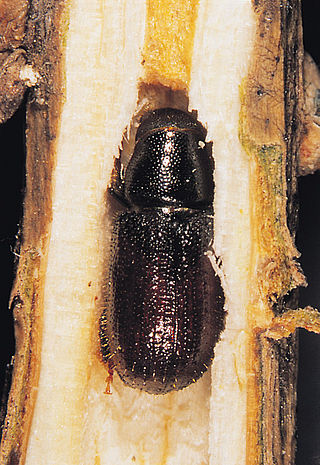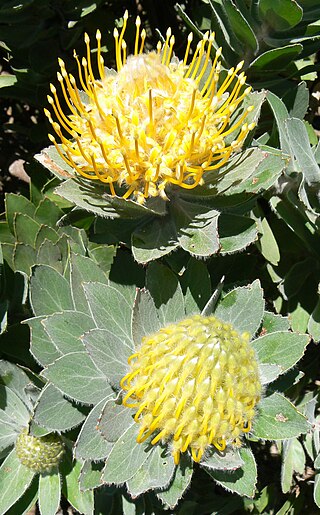
Conifers are a group of cone-bearing seed plants, a subset of gymnosperms. Scientifically, they make up the division Pinophyta, also known as Coniferophyta or Coniferae. The division contains a single extant class, Pinopsida. All extant conifers are perennial woody plants with secondary growth. The great majority are trees, though a few are shrubs. Examples include cedars, Douglas-firs, cypresses, firs, junipers, kauri, larches, pines, hemlocks, redwoods, spruces, and yews. The division Pinophyta contains seven families, 60 to 65 genera, and more than 600 living species.

Pinus canariensis, the Canary Island pine, is a species of gymnosperm in the conifer family Pinaceae. It is a large, evergreen tree, native and endemic to the outer Canary Islands of the Atlantic Ocean.

Pinus elliottii, commonly known as slash pine, is a conifer tree native to the Southeastern United States. Slash pine is named after the "slashes" – swampy ground overgrown with trees and bushes – that constitute its habitat. Other common names include swamp pine, yellow slash pine, and southern Florida pine. Slash pine has two different varieties: P. e. var. elliottii and P. e. var. densa. Historically, slash pine has been an important economic timber for naval stores, turpentine, and resin. The wood of slash pine is known for its unusually high strength, especially for a pine. It exceeds many hardwoods and is even comparable to very dense woods such as ironwood.

The stone pine, botanical name Pinus pinea, also known as the Italian stone pine, Mediterranean stone pine, umbrella pine and parasol pine, is a tree from the pine family (Pinaceae). The tree is native to the Mediterranean region, occurring in Southern Europe and the Levant. The species was introduced into North Africa millennia ago, and is also naturalized in the Canary Islands, South Africa and New South Wales.

Pinus halepensis, commonly known as the Aleppo pine, also known as the Jerusalem pine, is a pine native to the Mediterranean region.

Pinus roxburghii, commonly known as chir pine or longleaf Indian pine, is a species of pine tree native to the Himalayas. It was named after William Roxburgh.

Pinus aristata, the Rocky Mountain bristlecone pine, is a long-living species of bristlecone pine tree native to the United States. It appears in the Rocky Mountains in Colorado and northern New Mexico, with isolated populations in the San Francisco Peaks in Arizona and the Kaibab National Forest north of the Grand Canyon. It is usually found at very high altitudes, from 7,000–13,000 feet (2,100–4,000 m), in cold, dry subalpine climate conditions, often at the tree line, although it also forms extensive closed-canopy stands at somewhat lower elevations.

Pinus gerardiana, commonly known as the chilghoza pine or neja, is a pine native to the northwestern Himalayas in Afghanistan, northern Pakistan, Waziristan and northwestern India, growing at elevations of 1,800–3,350 metres (5,910–10,990 ft). It often occurs in association with Cedrus deodara, and Pinus wallichiana.

Picea glauca, the white spruce, is a species of spruce native to the northern temperate and boreal forests in North America. Picea glauca is native from central Alaska all through the east, across western and southern/central Canada to the Avalon Peninsula in Newfoundland, and south to Montana, North Dakota, Minnesota, Wisconsin, Michigan, Upstate New York and Vermont, along with the mountainous and immediate coastal portions of New Hampshire and Maine, where temperatures are just barely cool and moist enough to support it. There is also an isolated population in the Black Hills of South Dakota and Wyoming. It is also known as Canadian spruce, skunk spruce, cat spruce, Black Hills spruce, western white spruce, Alberta white spruce, and Porsild spruce.

Acacia saligna, commonly known by various names including coojong, golden wreath wattle, orange wattle, blue-leafed wattle, Western Australian golden wattle, and, in Africa, Port Jackson willow, is a small tree in the family Fabaceae. Native to Australia, it is widely distributed throughout the south west corner of Western Australia, extending north as far as the Murchison River, and east to Israelite Bay. The Noongar peoples know the tree as Cujong.

Secondary succession is the secondary ecological succession of a plant's life. As opposed to the first, primary succession, secondary succession is a process started by an event that reduces an already established ecosystem to a smaller population of species, and as such secondary succession occurs on preexisting soil whereas primary succession usually occurs in a place lacking soil. Many factors can affect secondary succession, such as trophic interaction, initial composition, and competition-colonization trade-offs. The factors that control the increase in abundance of a species during succession may be determined mainly by seed production and dispersal, micro climate; landscape structure ; bulk density, pH, and soil texture.

Wilding conifers, also known as wilding pines, are invasive trees in the high country of New Zealand. Millions of dollars are spent on controlling their spread.

Tomicus piniperda, the common pine shoot beetle, is a bark beetle native throughout Europe, northwestern Africa, and northern Asia. It is one of the most destructive shoot-feeding species in northern Europe.

Dioryctria sylvestrella, the new pine knot-horn or maritime pine borer, is a moth of the family Pyralidae. It is found in Europe, parts of Asia and North Africa. The adult is a small mottled brown and white insect with a wingspan of 28 to 35 mm. The moth flies in a single generation from June to October and is a pest of maritime pine and several other species of pine, on which the caterpillars feed.

Newlands Forest is a conservancy area on the eastern slopes of Table Mountain, beside the suburb of Newlands, Cape Town, South Africa. It is owned and maintained by the Table Mountain National Parks Board, along with the City Parks Department of Cape Town, and includes a Fire Station, Nursery and Reservoir.

Cape Flats Sand Fynbos (CFSF), previously known as Sand Plain Fynbos, is a critically endangered vegetation type that occurs only within the city of Cape Town. Less than 1% of this unique lowland fynbos vegetation is conserved.

Peninsula Granite Fynbos is an endangered Fynbos vegetation type which is endemic to the city of Cape Town and occurs nowhere else. It is a unique type of tall, dense and diverse scrubland, scattered with trees. It can be found all along the belt of granite that encircles Table Mountain.

Fusarium circinatum is a fungal plant pathogen that causes the serious disease pitch canker on pine trees and Douglas firs. The most common hosts of the pathogen include slash pine, loblolly pine, Monterey pine, Mexican weeping pine, and Douglas fir. Like other Fusarium species in the phylum Ascomycota, it is the asexual reproductive state of the fungus and has a teleomorph, Gibberella circinata.

Cecilia is a section of the Table Mountain National Park on the lower eastern slopes of Table Mountain in Cape Town, located just to the south of Kirstenbosch National Botanical Garden. It was previously used for commercial logging and known as Cecilia Forest or Cecilia Plantation, but has now been given protected status and integrated into the National Park.


























